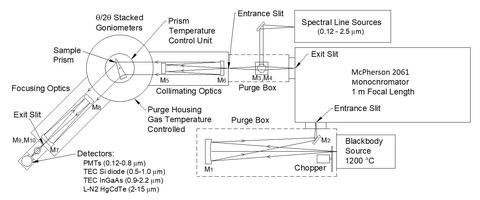Minimum-Deviation-Angle Refractometry System

Schematic diagram of the NIST Minimum Deviation Angle Refractometry System
High-accuracy index of refraction measurements are made at NIST using a custom minimum-deviation-angle refractometry system. It uses all-reflective optics and a suite of sources and detectors, enabling the system to achieve diffraction-limited index measurements for wavelengths through the range to 0.12 μm to 15 μm, near room temperature. This system can be used to measure the index of any material transmitting in this wavelength range, that can be made into a prism of sufficient optical quality. It can also be used to measure the index of liquids using prism liquid cells. A schematic of the system is included in the figure.
Refractometer Specifications:
- Focal Length: 0.5 m.
- F-number: 10.
- Goniometer angle accuracy (standard uncertainty): 0.2 arc-sec.
- Wavelength range: 0.12 mm to 15 mm (using various sources and detectors).
- Wavelength Sources: monochromator-filtered blackbody source, various lasers, and various spectral lamps.
- Detectors: Liquid-cooled HgCdTe, various diode detectors, and various photomultiplier tubes (PMTs).
- Operational temperature range: 15 °C to 25 °C.
- Can measure the index of both polarizations for birefringent crystals if the crystal axes are oriented appropriately.
- Can measure the index temperature dependence (dn/dT): Obtained from index measurements at various temperatures in the range: 15 °C to 25 °C. Uncertainty depends on the temperature range, and on the uncertainties in the index and the temperature.
Index Measurement Specifications:
- Wavelength range: 0.12 mm to 15 mm.
- Sample requirements:
- Sample configuration: For solids: prism with sizes ranging from ~1 mm to 60 mm; for liquids: volume ≥10 ml (measurements made in custom prism cells).
- Sample specifications: The index measurement uncertainty achievable for a given material depends the sample geometry parameters: prism dimensions, prism apex angle, and the flatness of the surfaces. The uncertainty also depends on the material quality parameters: stress-induced birefringence and the homogeneity. Achieving diffraction-limited uncertainties requires meeting specifications specific to the material.
- Sample absorbance: transmission at least 10% through all regions of clear aperture.
- Index accuracy: diffraction-limited for a given sample size if the sample meets fabrication specifications specific to the material. For samples sizes of ~25 mm, absolute standard uncertainties can be achieved ranging from 0.4 x 10-6 to 30 x 10-6 for wavelengths from 0.12 mm 15 mm.
- Measurement temperature range: 15 °C to 25 °C, with absolute standard temperature uncertainty: uT(°C) = 0.005 °C.
Related Measurements
Obtaining accurate index values requires a number of peripheral measurements, using facilities at NIST. These measurements include:
- Prism apex angle measurements with accuracy below 0.1 arc-sec, using NIST’s Advanced Automated Master Angle Calibration System.
- Transmission measurements for wavelengths from 0.12 mm to 80 mm, using various grating and FT spectrometers.
- Grown-in stress induced birefringence measurements for wavelengths from 0.12 mm to 2 mm, using polarimetry.
- Spatial-dispersion-induced birefringence measurements for wavelengths from 0.12 mm to 2 mm, using polarimetry.
- Index homogeneity measurements using the high accuracy 633 nm interferometer at in NIST Optics Metrology Lab.
- Surface figure measurements using the NIST Optics Metrology Lab.
- Crystal-axis orientation measurements using custom NIST Laue X-ray diffraction system.

